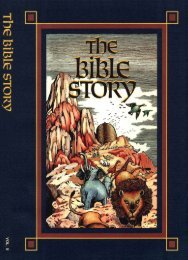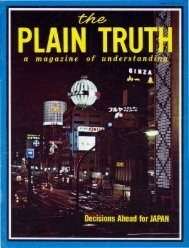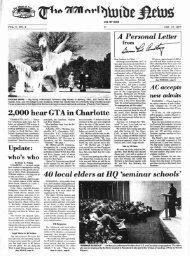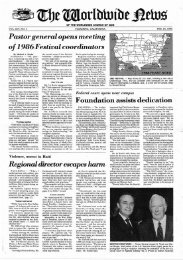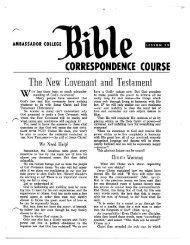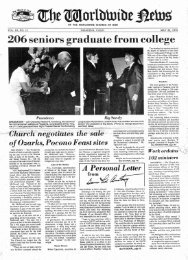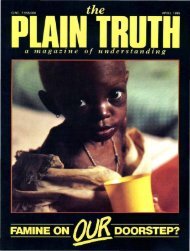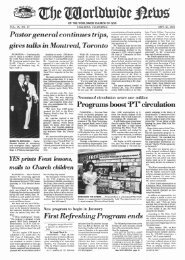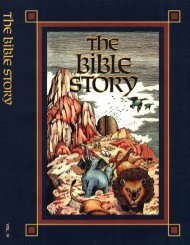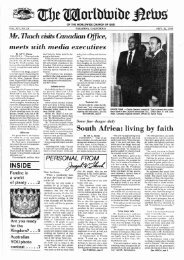Plain Truth 1978 (Prelim No 04) Apr - Herbert W. Armstrong
Plain Truth 1978 (Prelim No 04) Apr - Herbert W. Armstrong
Plain Truth 1978 (Prelim No 04) Apr - Herbert W. Armstrong
You also want an ePaper? Increase the reach of your titles
YUMPU automatically turns print PDFs into web optimized ePapers that Google loves.
necessary to turn to the much more<br />
complicated sexual method?<br />
Sex Vs. <strong>No</strong> Sex<br />
Indeed, the great advantage of asexual<br />
reproduction is its reliability and<br />
simplicity. For one-celled creatures,<br />
sim pie division is all that is necessary.<br />
On the other hand, sexual reproduction<br />
requires two individuals<br />
to find each other and to mate in<br />
order to let their gametes-sperm<br />
and egg-fuse and then divide to<br />
create another organism like themselves.<br />
Asexual reproduction can<br />
also proceed more rapidly and allow<br />
populations to build up much more<br />
quickly than sexual reproduction.<br />
Since asexual reproduction has so<br />
many advantages, it is difficult to see<br />
why nonsexual creatures would ever<br />
turn to sex; they obviously survive<br />
. quite well without it. Witness three<br />
billion years of asexual bacterial reproduction<br />
with no significant<br />
changes.<br />
Of course, sex might produce a<br />
greater variety of offspring, which<br />
could perhaps better adapt to<br />
changing environments. But no<br />
nonsexual creature could be expected<br />
to "know" that sex is better,<br />
and considering the intricate difficulties<br />
in changing from nonsex to<br />
sex, it is not surprising that evolutionary<br />
theory is extremely hard<br />
pressed to explain how sex arose.<br />
Take the common dandelion,<br />
surely an example of a prospering<br />
flowering plant (ask any gardener).<br />
Dandelions are presumably the result<br />
of millions of years of sexual variation.<br />
But in actual fact the dandelion<br />
produces seeds by asexual means!<br />
Everyseed isageneticduplicateofthe<br />
parent. Biologists therefore conclude<br />
that the dandelion has "abandoned"<br />
sex and is thus extremely unlikely to<br />
ever show any significant change.<br />
Which again emphasizes the basic<br />
paradox of sex. A sexless world <br />
whether of single- or multiple-celled<br />
organisms-would be a world with<br />
little hope of evolutionary modification<br />
. But for sexless forms of life<br />
to ever evolve by mere mutations<br />
into sexual forms would seem to be<br />
utterly impossible.<br />
Sex, in all its many variations, cannot<br />
be the result of chance mutations.<br />
Sex must be the product of a Great<br />
Designer and Creator. 0<br />
The PLAIN TRUTH <strong>Apr</strong>il <strong>1978</strong><br />
Evolution, Sex and the Ant<br />
Surprising as it may seem , the tiny<br />
ant poses one of the biggest challenges<br />
to the belief that sex is a<br />
product of evolution and the survival<br />
of the fittest, or, on the other<br />
hand, that evolution is the natural<br />
result of sexual reproduction. One<br />
problem lies in the existence of<br />
sterile female workers in the ant<br />
community. Indeed, Charles Darwin,<br />
the father of the theory of<br />
evolution, was concerned that such<br />
neuter worker ants could be "actually<br />
fatal to the whole theory."<br />
In his 1859 book Origin ofSpecies,<br />
Darwin stated: "With the working<br />
ant we have an insect differing<br />
greatly from its parents, yet absolutely<br />
sterile; so that it could never<br />
have .transmitted successively acquired<br />
modifications of structure<br />
or instinct to its progeny. . .. It<br />
may well be asked, how is it possible<br />
to reconcile this case with the<br />
theory of na tural selection?"<br />
And that's precisely the point:<br />
These highly specialized workers<br />
differ greatly from their mother,<br />
father, and even from each other.<br />
Darwin observed that they differed<br />
by "an almost incredible degree."<br />
So one might assume they<br />
became specialized by evolution<br />
and natural selection over millions<br />
of years. But they're sterile! So<br />
they couldn't possibly have<br />
evolved by passing on characteristics<br />
to their offspring.<br />
But could the queen ant, the<br />
mother of the neuter workers , be<br />
the source of their "evolution"?<br />
Modern-day evolutionists speculate<br />
that perhaps fortuitous mutations<br />
or sexual recombinations in<br />
the genes of ant queens gave rise<br />
to the remarkable variety of highly<br />
adapted workers we now find in<br />
ant colonies . After all, unlike the<br />
workers, queen ants are sexual<br />
creatures. Therefore, according to<br />
evolutionary theory, they might be<br />
expected to more readily evolve,<br />
introducing a wide variety of innovations<br />
in their offspring.<br />
But the evidence simply does<br />
not support such speculation. Fossilized<br />
ants-males, females, and<br />
workers dated some 70 million<br />
years old-are apparently identical<br />
with species now living! Queen<br />
ants are a result of sexual reproduction.<br />
Yet the enigma is that sex,<br />
the presumed source of great evolutionary<br />
variety and change, has<br />
seemingly failed to effect any significant<br />
changes since the time of<br />
the fossilized ants. Sex or no sex,<br />
the evidence is that for millions of<br />
years the ant has not evolved.<br />
Surely the tiny ant provides a<br />
major challenge to Darwinian concepts<br />
ofevolution.<br />
19



